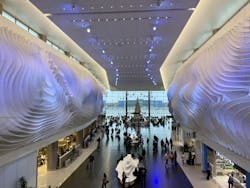Matt Needham, Director of Aviation and Transportation for HOK, explained, “You've got deliveries, you've got a central plant, you've got an enormous amount of people. You've got a train system. You've got people who are coming to and from the original origin and destination passengers, and then you've got transfers from a hub.”
A lot goes into running and maintaining a city, just like it does airports. Imagine one day the city you live in says, “we’re starting over”. You may ask, “well, what does that mean?”, or “how will we remain operational under construction?” or “what’s staying the same, and what’s changing?”
The same questions get asked hundreds of times when an airport “starts over” and decides to build a new facility.
So, the question remains … “what does it take to build a self-contained city?”. Over the past few years, the Salt Lake City International Airport (SLC) asked and answered that very same question.
SLC embarked on the mission to build a brand-new airport in 2010. The need for a new airport in Salt Lake City had been on the horizon since the 90s. However, circumstances, such as the events of 9/11 and the Great Recession in 2008, delayed the project until 2010-2011.
In that period, SLC selected HOK as the architect of record and a combination of national and local construction firms: Big B and Okland Brothers from Salt Lake City, Holder from Atlanta, and Austin Construction from Texas.
“We explored the possibility of rehabilitating the existing concourses, aiming for a unified terminal in Phase One,” Needham said. However, as the design progressed, the cost difference between full rehabilitation and new construction was minimal. Thus, the decision was made to proceed with all-new facilities.
The primary driver for this monumental project was the need to accommodate passenger growth. The old airport's layout, with its finger pier design, caused congestion and delays for airlines.
Bill Wyatt, the Executive Director of Airports for Salt Lake City, said the decision to fix this layout became crucial for the success of Salt Lake as a hub.
"Most U.S. airports today are 60, 70, some even 80 years old, and such was the case here in Salt Lake City,” he said.
Prior to opening The New SLC, the airport served more than 26 million passengers a year from facilities that were designed 50 years ago, which were intended to serve half as many travelers.
Wyatt said a lot has changed since the early 1960s. SLC has grown into a hub airport, with many flights arriving and leaving around the same time. Security needs have evolved, and there was a need for buildings that met earthquake safety standards.
“SLC's former facilities served the community well, but it was time to make way for the next generation of airport design,” he said.
The New SLC
The project comprises four phases, with the first phase opening in September (Concourse A) and October (Concourse B) 2020.
“The first was really the most significant because it includes all of the actual terminal facilities: check-in, baggage, et cetera, and also all of the landside facilities, so all the parking, rental cars,” Wyatt said.
Phase Two, completed in the fall of 2023, extended the A Concourse by 22 more gates. Wyatt pointed out that the design consistency across phases ensures a seamless experience for travelers. "All the gates, the restrooms, the concession areas, they all have a very similar look and feel."
Phase Three includes a Central Tunnel (River Tunnel) connecting Concourses A and B; plus five additional gates initially opening in fall 2024 then 10 opening in fall 2025.
“The old airport, I like to tell people, looked like the palm of my hand, and had these pincer sort of concourses moving out. Great for a small-town airport, which is what it was back when it was built, not great for a hub airport. It really restricted the movement of aircraft,” Wyatt said. “So, Phase Three, which is a design of two long, parallel concourses, is the opening of the Central Tunnel (River Tunnel) and the gates and the connecting infrastructure right on the other side from Concourse A to Concourse B. It'll really change the passenger experience a lot.”
Additionally, a larger Delta Sky Club will be built in Concourse B, “When that opens, we'll have 60,000 square feet of Sky Club. And of course, we are a Delta hub, so that's very important for them and for their connecting passengers and local as well,” Wyatt said.
While Phase Four was initially a future consideration, increased traffic post-COVID prompted plans to add more gates sooner than expected. "Salt Lake is going to go from an airport that had 52 jet bridges to one that has 94 in the space of seven years."
Regarding future phases, Wyatt clarified, "We have a Concourse A. We have a Concourse B. The next concourse would be a C and after that would be a D." Although there are no immediate plans for Phases Five and Six, the airport is preparing for future expansion with enabling work currently underway.
Future-Ready Design Elements
Wyatt said a large part of the planning and design of The New SLC was not just laying out the groundwork for the current project, but also thinking about future projects and how those might be incorporated.
A great example of this is a heavy automated people mover (APM) system designed for future phases.
“While the initial opening of the tunnel focuses on pedestrians with moving walkways and shuttles, the train tunnels are concealed and will be activated for future expansion,” Needham said.
Needham said considering the complexity of building a new airport, certain key elements must be considered for future expansion and smooth transitions.
“Flexibility is crucial. The design must accommodate changes that cannot be anticipated, allowing for easy expansion of gates, processing facilities, and other essential services,” he said. “The team's collaborative efforts are vital in addressing the challenges of keeping the existing airport operational during construction.”
Needham said airports need to aim for a framework designed to last 50-plus years, providing room for growth and adaptation. Considering the airport as a self-contained city, the design should prioritize efficiency, sustainability, and a sense of place.
Wyatt stressed the importance of flexibility in airport design to accommodate future changes. "Build flexibility in because none of us really knows exactly where things are headed."
Creating a Sense of Place
“One of the things the city did very early on that I think was just visionary was asking people here in Utah, ‘What do you want to see in a new airport?’,” Wyatt said. “A constant theme came up, which is we want people to know where they are, even if they're not leaving the airport. So, the colors, the textures, the art all reflect that.”
Upon entering the airport, visitors will be greeted by a stunning visual representation of Utah’s slot canyons depicted in 3D on the walls, highlighted by orange, blue, purple and yellow lights. Throughout the airport, the slot canyons continue to make an appearance from unique and fun furniture to artist installations featured throughout the tunnels.
The Central Tunnel, also known as the River Tunnel, is a key feature of Phase Three, designed to transport passengers both physically and mentally.
“The canyon design in the main terminal reflects the geological layers found in southern Utah,” Needham explained, “The art in the River Tunnel represents the erosion process that created these slot canyons, offering passengers a unique and immersive experience during their journey.”
The emphasis on creating a sense of place for all travelers continues throughout the airport by “integrating local elements, such as the copper sheen exterior representing copper mining, and the "family room" for welcoming returning loved ones, reflects a commitment to making the airport a unique and meaningful experience for all,” said Needham.
The ”family room”, AKA post-security waiting area, featuring cozy chairs, a fireplace and restaurant, can be found as travelers make their way to baggage claim.
Sustainability
The New SLC is committed to sustainability initiatives. Wyatt highlighted efforts such as natural light harvesting, minimal irrigation, and the reduction of electrical and water demand. The airport's parallel design has also contributed to significant carbon savings by reducing taxi time for aircraft.
Discussing the future of airports, Wyatt touched upon emerging trends like AI and electrification. The airport is already in the process of electrifying its campus, with plans for shuttle buses and electric ground service equipment. "Electrification at airports is going to continue," he stated.
Needham said two other notable sustainability features in The New SLC include the use of embodied fly ash in the foundation, reducing embodied carbon, and the implementation of permanent magnet motors in the miles-long bag system.
“These motors save electricity by starting and stopping based on the system's demand, reducing overall energy consumption,” he said.
Passenger-Centric Approaches
Wyatt said every aspect of The New SLC was designed for the highest passenger experience, including concessions.
The airport's concessions program stands out for its commitment to street pricing, ensuring that passengers do not face inflated costs. Wyatt explained, "In a lot of airports they'll have a street plus 10, or a street plus 15, or maybe five, which is whatever it costs downtown plus 5% or 10% or 15%. And we said, ‘no, it's going to be street pricing’. And what that means is, you can come out to the airport, have a meal, buy a bottle of water, and not worry about being gouged.”
As a result, Wyatt said the concession sales are off the chart, “I think a large part of that is because people who have gotten used to the airport, come out here a lot and know that they can do that and not feel like it's going to cost them an arm and a leg.”
Since unveiling Phase One and Phase Two of The New SLC, Needham said the feedback has been overwhelmingly positive.
“Both airlines and passengers have experienced positive changes. The new layout facilitates smoother aircraft movements, reducing congestion. Passengers find it more convenient, with improved walking distances compared to the old airport,” he said.
Needham said such positive feedback is a result of strong teamwork since the very beginning stages of the project.
When asked what advice he would give to another airport looking to undergo a similar project he said, “The entire team needs to be engaged from the planning through the design and the construction as a single unit to really address everything that comes up, because we need to actually develop these 95 gates and bring them online simultaneously with the current airport and connect it to the old airport that was there while we were building. That is an incredible amount of coordination, particularly when you think about all the services that a major airport has in it.”
He continued, “When you go through multiple phases to keep that old airport open as long as you can, you've got to go through the analysis to keep the entire city running for each phase. And so, to really allow that to happen, you need a very highly collaborative team that works well together. And at the end of the day, not just has fun together, but has an amazing legacy to look back on.”
Wyatt said The New SLC has had a positive impact on the entire community.
“Something we're very proud of, The Salt Lake Tribune, which is one of our local newspapers, named the airport ‘Utahn of the Year for 2023’, and it's exciting for two reasons. One, the airport is not a person, which is normally the case for this award, but also really, I think it makes us all very proud because this is a recognition given to us by people who live here, who experience the airport,” he said.



